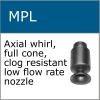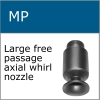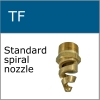The importance of droplet size in foam control
The basic mechanism for foam control is the droplet of suppressing spray hitting the foam bubbles and bursting them. Obviously the more droplets one has for any given volume of spray then the greater the potential for bubble bursting and foam suppression.
So it would seem logical that finer droplet size sprays are more effective and indeed this is true up to point. If, however, droplets become too small they may lack the momentum to burst foam bubbles and will simply bounce off them. If, on the other hand, the droplets are too large they may penetrate the foam layer completely and impact on the fluid below potentially causing more foam to be generated.
The balancing act
Successful foam suppression requires a balancing act between having spray size sufficiently fine to give a large number of bubble bursting droplets whilst keeping the droplet size large enough to actually burst the bubbles. Furthermore foam bubbles will often vary significantly in size and hence the droplets size required to burst the bubbles will also vary. As such a spray with a broad spectrum of droplet sizes may be more effective than one with a narrow droplet size spectrum.
Nozzle selection
The TF range of spiral nozzles are often used for foam suppression applications as they can be configured to distribute fluid over a very wide spray angle (up to 170 degrees) and they contain a broad spectrum of droplet sizes.
Another excellent choice for foam control applications is the Maxipass (MP) nozzle or the lower flow rate MPL. These nozzles are clog resistant and produce a more even full cone spray pattern than TF spiral nozzles. The spectrum of droplet sizes is more narrow but the more even overall distribution of fluid may be desirable in many situations.
Full details can be found by clicking on the boxes bellow


